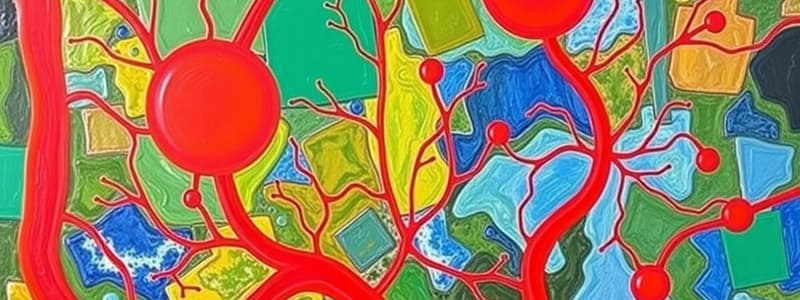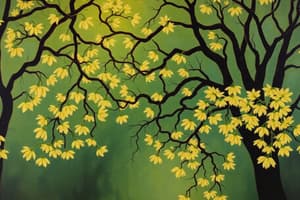Podcast
Questions and Answers
What is the primary function of blood in the human body?
What is the primary function of blood in the human body?
- To carry nutrients and oxygen to cells (correct)
- To maintain pH levels
- To regulate body temperature
- To produce hormones
Which vessels carry oxygenated blood away from the heart?
Which vessels carry oxygenated blood away from the heart?
- Venules
- Capillaries
- Veins
- Arteries (correct)
What type of circulatory system do arthropods possess?
What type of circulatory system do arthropods possess?
- Hydraulic circulatory system
- Pulsating circulatory system
- Closed circulatory system
- Open circulatory system (correct)
What causes the 'lub' sound in the heart?
What causes the 'lub' sound in the heart?
In which organisms does gas exchange occur directly between the surrounding water and the body fluid?
In which organisms does gas exchange occur directly between the surrounding water and the body fluid?
What percentage of blood is composed of plasma?
What percentage of blood is composed of plasma?
What is the primary function of the circulatory system in all organisms?
What is the primary function of the circulatory system in all organisms?
Which formed element in the blood is primarily responsible for oxygen transport?
Which formed element in the blood is primarily responsible for oxygen transport?
Which type of organism typically utilizes a pseudocoelom for circulation?
Which type of organism typically utilizes a pseudocoelom for circulation?
Which of the following components is NOT part of the blood plasma?
Which of the following components is NOT part of the blood plasma?
What distinguishes a closed circulatory system from an open circulatory system?
What distinguishes a closed circulatory system from an open circulatory system?
What is the lifespan of erythrocytes in the human body?
What is the lifespan of erythrocytes in the human body?
How does water enter the sponge for gas exchange?
How does water enter the sponge for gas exchange?
What type of blood vessel is mainly responsible for nutrient and gas exchange?
What type of blood vessel is mainly responsible for nutrient and gas exchange?
Which organism is characterized as having a closed circulatory system?
Which organism is characterized as having a closed circulatory system?
What is the role of hemocoels in an organism with an open circulatory system?
What is the role of hemocoels in an organism with an open circulatory system?
What is the primary function of the circulatory system?
What is the primary function of the circulatory system?
What component divides the heart into two sides?
What component divides the heart into two sides?
Which part of the heart receives deoxygenated blood from the body?
Which part of the heart receives deoxygenated blood from the body?
What is the normal resting heart rate for an adult?
What is the normal resting heart rate for an adult?
What occurs when the tricuspid valve closes?
What occurs when the tricuspid valve closes?
What happens to blood in the lungs during gas exchange?
What happens to blood in the lungs during gas exchange?
How much blood does a typical adult heart pump with each heartbeat?
How much blood does a typical adult heart pump with each heartbeat?
What role do one-way atrioventricular valves play in the heart?
What role do one-way atrioventricular valves play in the heart?
What is the primary function of capillaries in the circulatory system?
What is the primary function of capillaries in the circulatory system?
Which structure is primarily responsible for preventing the backward flow of blood in veins?
Which structure is primarily responsible for preventing the backward flow of blood in veins?
Who was the first to demonstrate that the heart and blood vessels form a closed circulatory system?
Who was the first to demonstrate that the heart and blood vessels form a closed circulatory system?
What type of blood is carried by the superior and inferior venae cavae?
What type of blood is carried by the superior and inferior venae cavae?
Which of the following circulations is responsible for supplying blood to the heart muscle itself?
Which of the following circulations is responsible for supplying blood to the heart muscle itself?
What can be a consequence of a blockage in the blood vessels supplying the heart?
What can be a consequence of a blockage in the blood vessels supplying the heart?
What distinguishes capillaries from arteries and veins?
What distinguishes capillaries from arteries and veins?
Which statement about systemic circulation is true?
Which statement about systemic circulation is true?
Flashcards
Transport in Organisms
Transport in Organisms
The movement and distribution of materials, such as fluids and nutrients, within an organism.
Gas Exchange
Gas Exchange
The process of exchanging gases, such as oxygen and carbon dioxide, between an organism and its environment.
Circulatory System
Circulatory System
A system of tubes, vessels, and pumps that circulate blood or other fluids throughout an organism.
Open Circulatory System
Open Circulatory System
Signup and view all the flashcards
Closed Circulatory System
Closed Circulatory System
Signup and view all the flashcards
Hemolymph
Hemolymph
Signup and view all the flashcards
Hemocoels
Hemocoels
Signup and view all the flashcards
Heart
Heart
Signup and view all the flashcards
What does the heart do?
What does the heart do?
Signup and view all the flashcards
What is the heart?
What is the heart?
Signup and view all the flashcards
How fast does the heart beat?
How fast does the heart beat?
Signup and view all the flashcards
How is the heart divided?
How is the heart divided?
Signup and view all the flashcards
What's the difference between the right and left sides of the heart?
What's the difference between the right and left sides of the heart?
Signup and view all the flashcards
What are the chambers of the heart?
What are the chambers of the heart?
Signup and view all the flashcards
What are atrioventricular valves?
What are atrioventricular valves?
Signup and view all the flashcards
Where does deoxygenated blood enter the heart?
Where does deoxygenated blood enter the heart?
Signup and view all the flashcards
What is the role of veins in the circulatory system?
What is the role of veins in the circulatory system?
Signup and view all the flashcards
What are the largest veins in the body?
What are the largest veins in the body?
Signup and view all the flashcards
What are capillaries and what is their function?
What are capillaries and what is their function?
Signup and view all the flashcards
What are valves and what is their function?
What are valves and what is their function?
Signup and view all the flashcards
What causes the sounds of the heart?
What causes the sounds of the heart?
Signup and view all the flashcards
What is pulmonary circulation?
What is pulmonary circulation?
Signup and view all the flashcards
What is systemic circulation?
What is systemic circulation?
Signup and view all the flashcards
What is coronary circulation and how does it work?
What is coronary circulation and how does it work?
Signup and view all the flashcards
Left Atrium's Role
Left Atrium's Role
Signup and view all the flashcards
Mitral Valve Function
Mitral Valve Function
Signup and view all the flashcards
Aortic Valve Function
Aortic Valve Function
Signup and view all the flashcards
Heart Sound: Lub
Heart Sound: Lub
Signup and view all the flashcards
Heart Sound: Dub
Heart Sound: Dub
Signup and view all the flashcards
Systemic Circulation
Systemic Circulation
Signup and view all the flashcards
Blood Composition
Blood Composition
Signup and view all the flashcards
Red Blood Cells: Erythrocytes
Red Blood Cells: Erythrocytes
Signup and view all the flashcards
Study Notes
Transport in Organisms
- Transport in organisms is vital for moving materials like fluids and nutrients to all body parts.
- Transport methods vary based on organism size, complexity, and habitat.
- Simple animals (sponges and cnidarians): Gas exchange directly between water and circulating body fluid.
- In sponges, water enters through pores into the spongocoel for gas exchange.
- Cnidarians have a body wall one cell thick, allowing direct contact with the external environment.
- Roundworms use body fluids for circulation, as they are in contact with the tissues and organs.
- Two main circulatory types exist: open and closed.
- Open circulation: In invertebrates, hemolymph circulates through channels and cavities. Gas exchange happens in these cavities.
- Closed circulation: Blood circulates within vessels, pumped by the heart. Insects and arthropods have open circulatory systems.
- Vertebrates have closed circulatory systems, with hearts and blood vessels.
- Circulatory systems vary in the number of heart chambers among vertebrates.
- Circulatory systems are adapted to carry nutrients, gases, and remove wastes to keep the organism alive.
- The heart is a muscular organ that pumps blood throughout the body.
Heart Structure and Function
- An adult human heart beats approximately 72 times per minute, pumping about 5.5 liters of blood.
- Heart rate can vary based on activity (e.g., faster during exercise).
- An adult heart is about the size of a fist, composed of cardiac muscle, nervous tissue, and connective tissue.
- It's enclosed in a pericardium.
- The heart is divided into two sides (right and left) by a septum.
- The right side receives deoxygenated blood from the body, while the left side receives oxygenated blood from the lungs.
- Chambers: Atria (upper chambers) and Ventricles (lower chambers).
- Valves (atrioventricular and semilunar) prevent backflow.
- Key valves are the mitral, tricuspid, aortic, and pulmonary valves. Heart sounds are caused by valve closures (lub-dub).
- The pulmonary and systemic circulation circuits work together.
Blood and Circulation
- Blood carries nutrients, gases, waste products, and hormones.
- Blood is composed of plasma (liquid part) and formed elements (red blood cells, white blood cells, and platelets).
- Erythrocytes carry oxygen and carbon dioxide.
- Leukocytes help fight infection.
- Thrombocytes are essential in blood clotting.
- Arteries carry oxygenated blood away from the heart.
- Veins carry deoxygenated blood toward the heart.
- Capillaries connect arteries and veins, allowing exchange of materials between blood and cells.
- Renal circulation involves the kidneys filtering nitrogenous wastes from the blood.
- Coronary circulation supplies the heart muscle with blood.
Studying That Suits You
Use AI to generate personalized quizzes and flashcards to suit your learning preferences.




